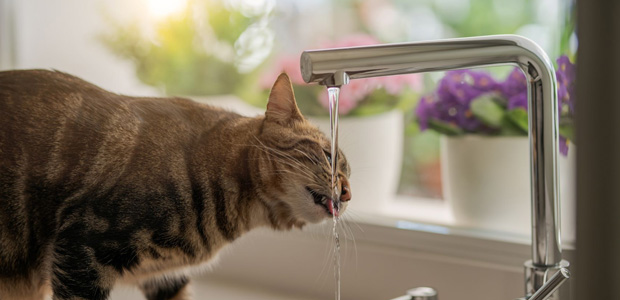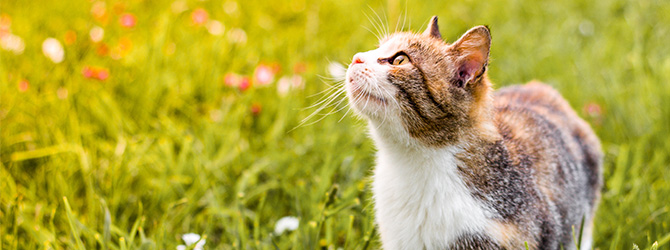Vet's 11 essential tips to keep cats cool in summer
Just like us, cats can get very hot during summer. Keeping your cat cool during the hottest months of the year is an important responsibility of any cat owner.
Cats don’t sweat as well as humans do, as they only have sweat glands on a few small areas of the body, mostly the feet. Cats also groom themselves to keep cool, as the evaporation of saliva helps regulate their body temperature. As a last resort, they may also pant, but this tends to mean the cat is already in some distress.
The good news is cats are generally good at regulating their body temperature and will seek out cooler areas if they’re too hot. They’re also less likely to engage in strenuous activity in high temperatures compared to dogs.
This doesn’t mean they never suffer heatstroke. While it’s less common in cats than dogs, it’s still a danger that owners of both indoor and outdoor cats should be aware of. To help, our vet has put together these tips on how to cool cats down.
1. Keep them hydrated
Just like us, cats can get hot during the warmer summer months. To prevent heat exhaustion, ensure your cat has access to fresh drinking water. Placing lots of bowls, cups, or glasses around the house in different spots will give your cat more options to drink from and keep them busy. Ensure your cat's water is full and fresh by replacing it daily, using any left over to water the plants. Never let the water stand for more than 24 hours. Many cats prefer running water, so consider a small cat drinking fountain. Some cats prefer to drink rainwater, so collect some and offer it to them in a bowl or tub.
You can give your cat some frozen treats too. Ice cubes in their water bowl will be a great addition, or you can let them play with an ice cube on its own. This is especially good in the kitchen, where there might be tiles so the cube can skid around. This is a lot of fun for cats, and also a lot of fun to watch. If you want to give your cat something more interesting, frozen chicken broth cubes or ice cubes made with water from cans of tuna can be great ideas.

2. Change your cat's diet
Cats get the majority of their water from their food. If your cat’s on a kibble diet, they'll need to drink more water to stay hydrated. Speak to your vet about switching to wet food, and transition slowly.
Alternatively, feeding them snacks such as spring water tuna can help them hydrate and give them a delicious treat. But remember to feed in moderation and talk to your vet before changing your cat's diet.
If you notice your cat showing any of the symptoms above, visit your vet immediately. Thankfully some steps can be taken before your cat reaches this critical stage.
3. Feed your cat a little and often
Cats are natural hunters, and their larger cousins in the wild are the kings of feast or famine. Our cats won't ever have the issue of wondering where their next meal comes from, but we can help them through the summer months by feeding them small amounts often. This will encourage outdoor cats to not stray too far away on hot days, and it also means they aren't exerting more energy digesting larger meals.
Also, consider feeding at night when it's cooler. This is especially important if your cat eats wet food, as during cooler hours it is much less likely that flies will take an interest in it. During the warmest hours of the day flies are likely to eat some and lay eggs on it.
4. Prevent sunburn
Cats can get sunburnt, especially hairless cats, or those with white or pale fur.
Keep them protected by ensuring they have access to shade at all times. If your cat is out exploring in the garden, they should gravitate naturally towards shaded areas, but in the middle of the day, when the sun is at its highest, think about bringing them indoors.
If your cat has white fur or their fur is very thin, treat them to some special sun cream! For more details on this, have a chat with your vet.
5. Provide a cool spot for your cat to lounge
Always ensure there are areas at home that are cool and well-ventilated where your cat can relax and cool down. Circulating cool air with fans or air conditioning can also help prevent cats from overheating.
6. Check your shed, garage, greenhouse or conservatory
Outdoor cats love a sun puddle and might enjoy nothing more than stretching out in your shed, garage, greenhouse or conservatory. Just make sure you don’t inadvertently lock them in as these buildings can heat up at the same rate as cars. Make sure you check them regularly, and keep doors and windows open wherever possible.
7. Provide cooling aids
Switching to a summer bed or a cooling mat can help keep cats cool during hot weather. Cooling mats designed for cats can help keep them cool without air conditioning. Another easy way to create a cooling aid is to wrap ice packs in towels or blankets, and giving them to your cats for them to lie on. You can also try putting a bottle of frozen water in front of a fan.

8. Keep them indoors
On those really hot days, consider restricting your cat’s access to the outdoors during the midday and early afternoon sun. Keep them inside for these hottest hours, with plenty of cool areas and fresh water available.
9. Keep them groomed
Long-haired cats may be especially prone to overheating. Keep on top of a regular grooming schedule and keep those furry coats under control.
10. Recognise the signs of heat exhaustion
Cats are very good at hiding when they're in distress from their owners. Because of this, it's up to us to read their body language and behaviour and understand when they're struggling. Signs of heat exhaustion in cats can include:
- Panting (which will become more intense as their condition worsens)
- Drooling
- Restlessness and pacing
- Vocalisation (especially if you have a quiet cat)
- Excessive grooming
As your cat's overheating increases, it can lead to heat stroke, which can be fatal. Signs of heatstroke include:
11. Be patient
Cats sleep for 16 to 20 hours a day, and in the summer months, this can rise to 22 hours. However, this can mean that cats become active once the sun goes down. If they get excited and wake you up with the zoomies or are just looking for attention, stay relaxed, don't scold them, and be happy they're happy.
What are the signs of heat stroke in cats?
Your cat may have heat stroke if they display any of these signs:
- Restlessness and excessive panting
- Sweaty paws
- Excessive grooming
- Difficulty walking
- Vomiting
- Seizures
If this happens, remove them from the heat as fast as you can. Offer them lots of water but in small, easy doses. Cool their fur with a damp cloth but avoid splashing them with water as this may cause shock. If you’re concerned, contact your vet.
Read more: Heat stroke in cats: how can I cool my cat down in warm weather?
Need more info?
To find out more about keeping your cat protected during the hot weather, have a chat with your local vet.
Find a Vet near you today or speak to a vet online from the comfort of your own home using Online Vets.



